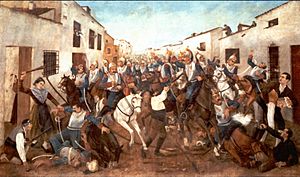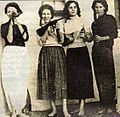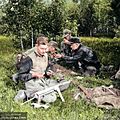Guerrilla warfare facts for kids
A guerrilla is a person, often a civilian, who fights against a larger, more organized army. Instead of big battles, guerrillas use surprise attacks and quick movements. This way of fighting is called guerrilla warfare. It's different from a regular war between two countries' armies. It's also different from terrorism, which is when civilians attack other civilians.
The word "guerrilla" comes from Spanish. It means "little war." It was first used in 1808. This was when Spain was invaded by Napoleon's army. Spanish people formed small groups to fight back. This conflict is known as the Peninsular War.

Contents
What is Guerrilla Warfare?
Guerrilla warfare is a special way of fighting. It involves small groups of fighters, called guerrilleros, attacking a larger, more powerful army. These fighters often know the local area very well. They use this knowledge to their advantage.
How Guerrillas Fight
Guerrillas usually avoid big, open battles. Instead, they use tactics like:
- Ambushes: Hiding and then suddenly attacking an enemy group.
- Sabotage: Damaging enemy supplies, roads, or communication lines.
- Hit-and-run attacks: Attacking quickly and then disappearing before the enemy can fight back.
- Surprise: Attacking when the enemy least expects it, often at night or in bad weather.
This type of fighting is very effective in places where a regular army has trouble moving around. This includes thick forests, high mountains, or crowded cities. Guerrilla fighters often blend in with the local people. This makes it hard for the enemy army to find them.
History of Guerrilla Warfare
Guerrilla tactics have been used for thousands of years. However, the term "guerrilla" became famous during the Peninsular War.
The Peninsular War (1808-1814)
In 1808, Napoleon's French army invaded Spain. The Spanish regular army was defeated. But many ordinary Spanish people refused to give up. They formed small, independent groups. These groups attacked the French soldiers. They cut off supplies and launched surprise raids. This constant harassment wore down the French army. This is where the term "guerrilla" (meaning "little war") became widely known.
Other Examples in History
Guerrilla warfare has been used in many conflicts around the world:
- Native Americans: In North America, Native American tribes often used guerrilla tactics against European settlers and armies. They knew the land well and used ambushes in forests.
- American Revolutionary War: American colonists used similar tactics against the British army. They used their knowledge of the land to surprise British forces.
- Boer Wars: In South Africa, Boer farmers used guerrilla tactics against the British army in the late 1800s and early 1900s.
- Vietnam War: During the Vietnam War (1955-1975), Vietnamese fighters used extensive guerrilla warfare against the American and South Vietnamese armies. They used tunnels, traps, and ambushes in dense jungles.
Why Guerrilla Warfare is Used
Guerrilla warfare is often used by groups who are much weaker than their enemy. They cannot win a traditional war. Instead, they aim to:
- Wear down the enemy's strength and morale over time.
- Force the enemy to spend a lot of resources and soldiers.
- Gain support from the local population.
- Make the enemy's occupation of a territory very difficult.
This type of fighting can be very long and difficult for both sides.
Images for kids
-
Boer guerrillas during the Second Boer War in South Africa
-
The Estonian Forest Brothers relaxing and cleaning their guns after a shooting exercise in Veskiaru, Järva County, Estonian SSR, in 1953
-
A Tuareg rebel fighter with a DShK on a technical in northern Niger, 2008
See also
 In Spanish: Guerra de guerrillas para niños
In Spanish: Guerra de guerrillas para niños






